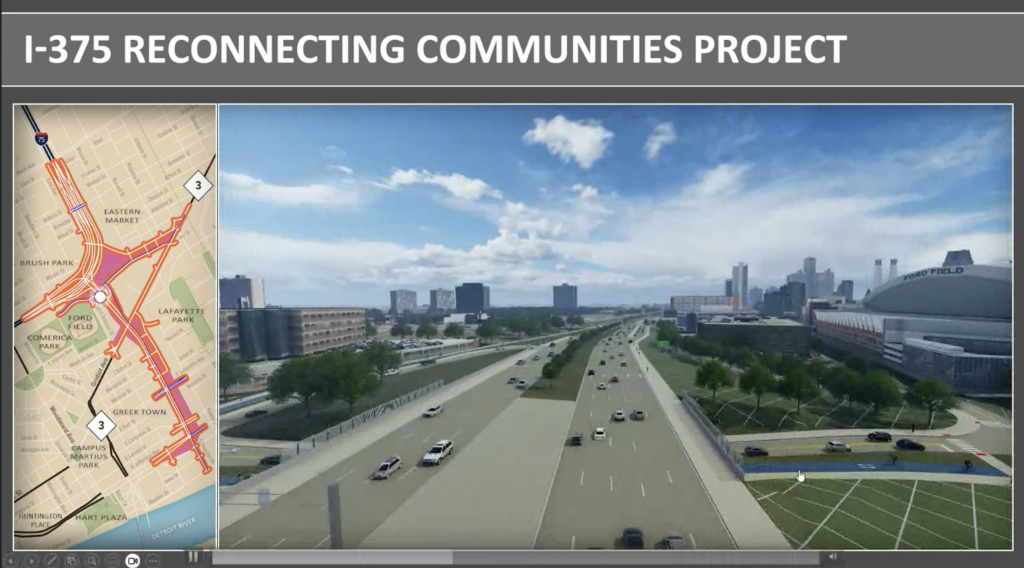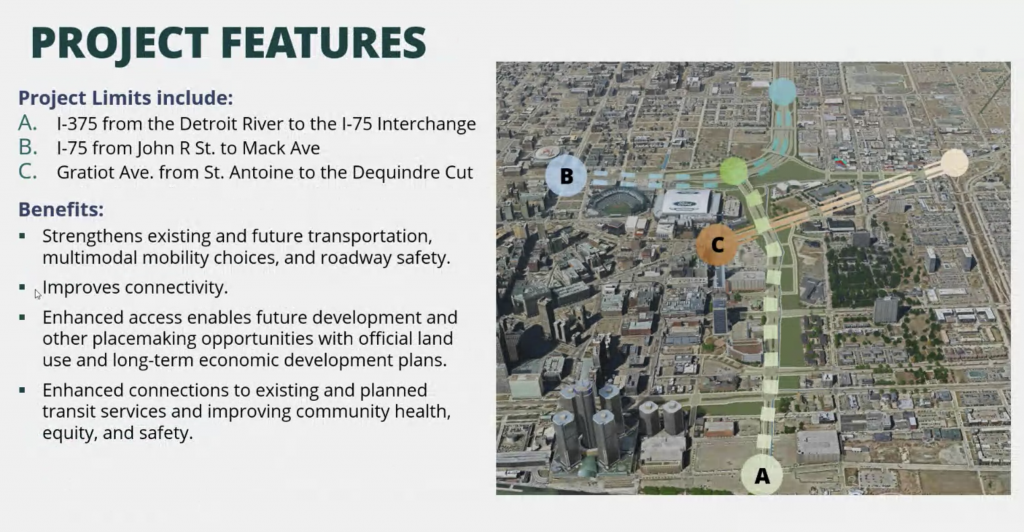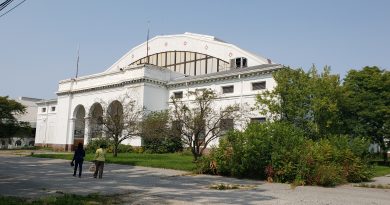MDOT: “An I-375 With Fewer Than Ten Lanes Would Take Away People’s Right To Get Around”
Of course, just a day after I wrote this piece praising the Michigan Department of Transportation’s forward-thinking vision (well, kinda) about the proposed renovation of Michigan Avenue in Detroit’s Corktown neighborhood, I have to return to my old ways. I attended the Green Task Force transportation committee yesterday, convened by Todd Scott of the Detroit Greenways Coalition, and our first presenter was from MDOT, talking about the I-375 Reconnecting Communities project.
Background. To the uninitiated, Interstate 375 was built in 1964 and briefly held the dubious distinction of being the shortest section of interstate in the country, until I-110 was completed in El Paso in 1967. Half a century later, we’re getting rid of it. Similar to other interstates that sliced through cities and demolished majority Black communities in the name of progress, this interstate was never a particularly good idea. Today, it functions as a funnel for traffic headed to Greektown Casino (5,000 cars per day for this exit alone), and traffic coming onto or off of Jefferson Avenue to one of downtown Detroit’s monumental office towers and their concomitant seas of parking lots and parking structures (47,000 cars per day on Jeff). The section of interstate itself handles around 40,000 cars per day, which compares with more than double that for the section to the north of the I-75/Gratiot interchange.

Removal of the interstate has been discussed for years. But MDOT dallied, and the governor’s office shelved the project indefinitely in 2020 before requesting federal funds to complete it from ARPA, etc. My interpretation, based on speaking with planners and other officials, is that this project was more or less shelved while other sexier projects like Cavnue and the Electreon PPP project were advanced instead. The new project, slated to begin in 2026, will create a surface-level boulevard that connects to not only Jefferson but also Gratiot and other streets. Gratiot is a well-trafficked thoroughfare, similarly way too wide, that funnels commuting traffic from downtown Detroit to Macomb County and vice versa.
After much ado about the road engineering agency’s emphasis on sustainability and community engagement, the MDOT representative proceeded to show the plans that the agency has tentatively settled on, which are the exact opposite of what the engaged community requested. People want narrower, safer streets. But this presentation includes– and I am not kidding here, look at the rendering- a ten-lane boulevard. No doubt if MDOT is engineering it, the lanes will also be as wide as possible to facilitate high speeds for vehicles, which are fundamentally unsafe for pedestrians or cyclists who will also share the street.
Asked why the project needed ten lanes, especially when the community requested fewer lanes and especially when the agency is ostensibly committed to decarbonization, the representative responded that this section of road is heavily-trafficked, and MDOT is required to take growth into account. Never mind that a connection with Gratiot Avenue would create a huge bottleneck of the 40,000 cars per day this gentleman still thinks will be coming through, and never mind that four years of construction will disrupt people’s travel to the point that they’ll consider plentiful alternatives: we must use the most recent numbers, says MDOT.
To the point about growth, though, the state isn’t growing– the governor convened a whole panel of wealthy people to talk about it– and MDOT refuses to acknowledge even the possibility of VMT reduction in the future, so it’s assuming that the amount of traffic will increase as the population inevitably increases (neither is inevitable). Recall that MDOT once said that they would refuse to take a position in favor of VMT reduction because they called it “punitive” and said they didn’t want to hurt anyone’s feelings.

Finally, in an absolute doozy, the representative also said that if we took lanes away, we’d be taking away people’s right to get around. This is a preposterous viewpoint for a public official to take, as it ignores that people need to be able to get around safely and affordably and that doesn’t necessarily mean driving a giant car at 55mph on a 25mph street (as they do here in Michigan). Of course, this representative of MDOT told us that he had been at the agency for 19 1/2 years, so it’s not terribly surprising, perhaps, that a career road engineer (at a road engineering agency that only hires road engineers) would advance fundamentally inaccurate talking points commonly parroted by road engineers. As society changes, evolves, and learns, should not the road engineering agency do the same?
I concluded my question by telling the gentleman– controversially, and I’m sure to the chagrin of some of the attendees- that they cannot build this project and claim to be serious about decarbonization and sustainability, to say nothing of the fact that the agency has systematically disregarded every public comment in favor of a narrower street.
There are transformative projects in the works in these parts, like the Joe Louis Greenway, or the ongoing transformation of the Detroit Riverfront. The JLG, for its part, promises to transform entire neighborhoods and create a blueprint for accessible mobility. This project is certainly transforming something. But it’s doing it at an insane cost, and the project should absolutely not go forward as MDOT is envisioning it. You can write to MDOT to tell them your thoughts— which, given the rendering above, it seems they’re likely to ignore. But it is absolutely vital that we keep pushing for sustainable transportation solutions, and those do not include freeway widening, nor do they include continuing to build as though trees will grow to the moon and everybody will have to drive around in their own car.
That’s not decarbonization. It’s just unimaginative, stale, bad planning.
MDOT had not responded to a request for comment as of the time of publication.


